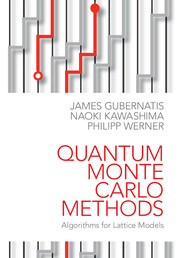Book contents
- Frontmatter
- Contents
- Preface
- Part I Monte Carlo basics
- Part II Finite temperature
- 6 Finite-temperature quantum spin algorithms
- 7 Determinant method
- 8 Continuous-time impurity solvers
- Part III Zero temperature
- Part IV Other topics
- Appendix A Alias method
- Appendix B Rejection method
- Appendix C Extended-ensemble methods
- Appendix D Loop/cluster algorithms: SU(N) model
- Appendix E Long-range interactions
- Appendix F Thouless's theorem
- Appendix G Hubbard-Stratonovich transformations
- Appendix H Multi-electron propagator
- Appendix I Zero temperature determinant method
- Appendix J Anderson impurity model: chain representation
- Appendix K Anderson impurity model: action formulation
- Appendix L Continuous-time auxiliary-field algorithm
- Appendix M Continuous-time determinant algorithm
- Appendix N Correlated sampling
- Appendix O The Bryan algorithm
- References
- Index
8 - Continuous-time impurity solvers
from Part II - Finite temperature
Published online by Cambridge University Press: 05 May 2016
- Frontmatter
- Contents
- Preface
- Part I Monte Carlo basics
- Part II Finite temperature
- 6 Finite-temperature quantum spin algorithms
- 7 Determinant method
- 8 Continuous-time impurity solvers
- Part III Zero temperature
- Part IV Other topics
- Appendix A Alias method
- Appendix B Rejection method
- Appendix C Extended-ensemble methods
- Appendix D Loop/cluster algorithms: SU(N) model
- Appendix E Long-range interactions
- Appendix F Thouless's theorem
- Appendix G Hubbard-Stratonovich transformations
- Appendix H Multi-electron propagator
- Appendix I Zero temperature determinant method
- Appendix J Anderson impurity model: chain representation
- Appendix K Anderson impurity model: action formulation
- Appendix L Continuous-time auxiliary-field algorithm
- Appendix M Continuous-time determinant algorithm
- Appendix N Correlated sampling
- Appendix O The Bryan algorithm
- References
- Index
Summary
This chapter, like the previous one, describes quantum Monte Carlo methods for the simulation of a system of interacting electrons at nonzero temperature. Here, we target a particular class of problems, characterized by a small number of correlated sites or orbitals, that we call impurity problems. While we could apply the methods of the previous chapter to such impurity models, the algorithms discussed here are more advantageous not only because they work in continuous imaginary time and hence lack the Trotter approximation error inherent to the previous methods, but also because they manipulate determinants of matrices of smaller size, which can be handled more efficiently. At the same time, the continuous-time approach is applicable to broader classes of impurity problems.
Driving the development of these continuous-time impurity solvers was the desire to perform more efficient simulations of correlated lattice models within the framework of dynamical mean-field theory. This formalism maps the lattice problem onto an impurity problem, whose parameters are determined by a self-consistency condition. In some cases, the self-consistent solution gives a good approximation of the properties of the original lattice problem. When we combine this dynamical mean-field approximation with the local-density approximation for electronic structure calculations, we obtain a powerful scheme for electronic structure calculations of strongly correlated materials. In this chapter we discuss the most important classes of impurity models, sketch the basics of the dynamical mean-field approximation, and detail the different variants of continuous-time impurity solvers.
Quantum impurity models
A quantum impurity model describes an atom or molecule embedded in some host with which it exchanges electrons, spin, and energy. This exchange allows the impurity to make transitions between different quantum states, and in the presence of interactions within or between the impurity orbitals, these transitions lead to nontrivial dynamical properties. Quantum impurity models play a prominent role, for example, in the theoretical description of the magnetic and electric properties of dilute metal alloys and in theoretical studies of quantum dots and molecular conductors. These models also appear as an auxiliary problem whose solution yields the dynamical mean-field description of correlated lattice models.
- Type
- Chapter
- Information
- Quantum Monte Carlo MethodsAlgorithms for Lattice Models, pp. 214 - 264Publisher: Cambridge University PressPrint publication year: 2016

